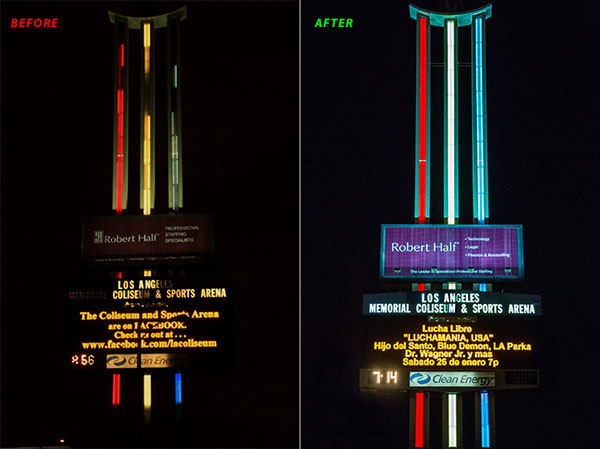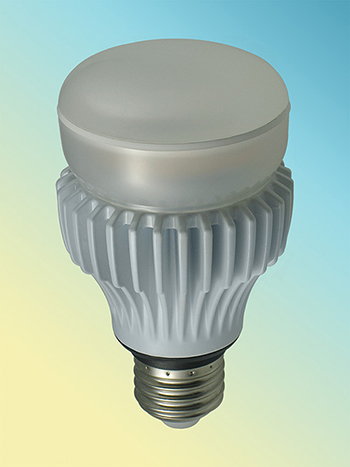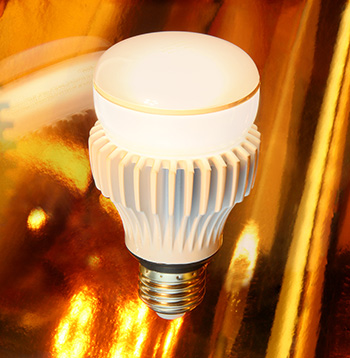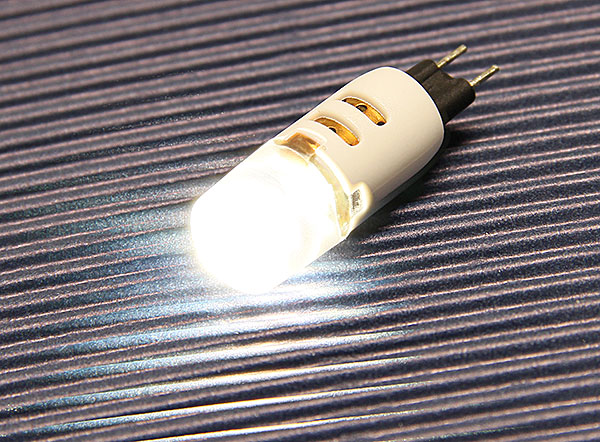With my 40-year background in LED technology, Editor Keith Dawson asked me to provide a historical overview of the development of LED technology and the applications it was suited for at each stage. To start, the LED chip, or Light Emitting diode, was first invented over 100 years ago. But at that time, scientists felt it was useless, put it aside and focused on other things.
Finally, in the 1960s, the tiny dot of LED (in deep red only) which is the diode and barely visible at just 1 or 2 millicandela, came back. One company called Monsanto made the chip, and another company called Fairchild, molded the chip. That tiny dot of LED started appearing in wristwatches which were used as giveaways at gas stations, store openings, etc. It was very exciting to see that red dot at the time!
Then, in the beginning of the 70’s, when I had the opportunity to look at packaging LED technologies, chips came out using gallium phosphide and gallium arsenide phosphide. With these chemicals, gallium arsenide phosphide provided red, and gallium phosphide gave us green and yellow and the first, commercial LEDs. These were very low intensity, like 10 or 15 millicandela, .015 or .012.
In 1972, when I was one of the junior partners of my elder brother’s company, I worked with molded LEDs in the three colors. The encapsulation epoxy was transparent, and I noticed that they were giving a narrow beam. Plus, it looked like the filament-technology bulb without the base. That’s when I got the idea of putting a base and a resistor and everything else on the LED so that it could be run at a certain voltage.
The only problem was that the beam angle was a little too narrow. I played with it in terms of modifying the unit to give out wide angles. In the 70’s, you had this first generation of commercial LEDs that started becoming suitable for extremely low levels of lighting indicators. That means you didn’t project light. You just saw it.
Then in the 80's, gallium aluminum arsenide and gallium aluminum phosphide were used in LEDs. With these new semiconductors as diodes, the intensity became 100 to 200 millicandela. Everything was moving at a pace of about 10 years and becoming 10 times brighter.
These LED brightness levels could be used for new applications the lower level intensities were not suitable for.
Now, you could see a dot with a higher brightness, and these low-level illuminators were used in flashlights and panel indicators. This is when I started developing clusters where a few LEDs bunched together could be more useful.
For example, one of the biggest advantages of LEDs over the older filament technology was that there was no mechanical or electrical shock. If you had the original filament technology and the application was such that it saw mechanical shock and electrical shock when turning it on and off too many times, the filament would crystallize, and the lights would constantly go out.
With this in mind, I converted the old bulbs into LED bulbs. This way, you could press an on/off LED light many times, and it would never fail. I started working with Otis Elevator (which was one of the first companies to start using our direct incandescent replacement LEDs at that time), along with power plants, utility businesses, and the military which were now using LED lighting in their illuminated push-button switches and indicators. These buttons were for critical functions and could not fail.
Next came the 90’s when LEDs went up to 1000 lumens with gallium nitride technology in various colors. Suddenly, we had very bright colors of green, red, yellow, and blue. Then, scientists started using phosphorous coating over the blue chip, and white light came out of it. That was the breakthrough of the LED white light, which I thought would take another hundred years, and it happened much faster. This light was used in small flashlights, marker lights, large indicators, third brake-lights, machine status indicators in factories, and much more.
Today’s LED Light Growth
The explosive growth of LEDs in the last 10 years has now become 25,000 lumens. Today, over 90% of indoor and outdoor lighting applications can now be done with LEDs with a major reduction in energy. (Commercial LEDs are reaching 150 lumens per watt, while fluorescents are only 50 lumens per watt.)
Efficiency, the amount of light coming out and the lumens-per-watt are increasing. And in the early 2000’s, the cost was very high, but now, 10 years later, the cost is coming down.
The advancement of LEDs is very exciting, and I look forward to see what’s ahead.
What are your thoughts on the future of LED lighting process? Please comment below or write to me at www.ledtronics.com.
For more information about LED lighting, please comment below or write to me here.
Posted at All LED Lighting, 8/9/13
Visit Pervaiz on Google+ here.
LED lighting is everywhere, and home owners know that it is wise to change out their old, Incandescent, Halogen or Fluorescent bulbs for both environmental and economic reasons.
If they do buy the cheap or consumer-grade LED products, there will be a quality problem and many bulb failures. If it’s a quality product and they are willing to invest in the cost, then they are finding out that it is a very healthy return on their investment. Most can see the cost savings down the road, but to start, it can be expensive to change everything at once.
With this in mind, what can we do to help consumers get the final result they want as cost-effectively as possible? As LED lighting experts, we need to do our part in educating home owners.
Start with a Small, LED Project at Home
To start, I suggest home owners pick out one or two rooms in their homes where the lights are on most of the time. They will probably find that most of the bulbs are in the kitchen or family room, or a room a child uses frequently, and that’s it. Then, they can focus on changing the old technology and energy-hungry-bulbs to very low power, cool-vision-friendly, LED bulbs in those rooms only. It will make the most difference in the reduction in energy use, and they will see their electric bills dramatically reduced at a very fast pace.
Look at the Color Temperature
And when starting the process of changing old bulbs to LED lights, it’s also important for consumers to look at the predominant, color temperatures of the walls, décor, floor, furniture, artwork, or painting in each room. For example, white, grey, blue, and silver tones in the room would come alive with Cool or Pure White LED bulbs in the 5000K to 6000K color temperature. Or, Natural White or Daylight White LED bulbs in 3800K to 4200K color temperature would work where you have a mixture of colors from blues, grey, whites, red, green, orange, yellow, etc. And then, Warm color LED bulbs in the 2500K to 3000K color temperature work where most of your décor is brown, maroon and red tones, or there are dark wood floors or wall paneling and wall colors in the warm shades.
Remember, it’s not the light that LEDs produce. It’s the light reflected from the objects it hits that enhances those colors. When you see the different color temperatures, it’s the light reflecting off of the walls and surfaces in the room. That enhances your décor.
Additional LED Points for Home Owners
Another key point to remember when replacing old bulbs is to see if the light coming out of the bulb is going to the right direction and has the right beam-size. Old light bulbs give out a high percentage of light which is just light pollution. With LED bulbs and choosing the appropriate beam angles, you direct the light to the places and objects like sofas, tables, curtains, and paintings while reducing the amount of light where it is not necessary like empty walls, ceilings, etc. This way your room comes alive, and you get maximum energy reduction.
Once home owners establish these things along with the wattage of the bulb, or how bright it should be, etc., they can make better decisions about their LED lighting choices and save a great deal of money in the process.
What are your thoughts on this process?
For more information about LED lighting, please comment below or write to me here.
Posted at All LED Lighting, 6/12/13
Visit Pervaiz on Google+ here.

Pervaiz is the true American success story. After moving from Pakistan to Los Angeles in 1967, he started LEDtronics in his garage with his wife, Almas, in 1983. Pervaiz is the pioneer of LED lighting technology and LEDtronics, Inc. is now in its 30th year. He has created jobs for 100s of employees (many who have been with him for over 25 years), and he does extensive philanthropic work to provide light to those who have none across the world.
Educated and trained as a Mechanical Engineer, Pervaiz Lodhie’s entrepreneurial spirit brought him to the United States, where he was able in 1983 to fulfill his vision of creating a successful LED lighting company-LEDtronics, Inc., of Torrance, California. In the past 28 years the solid-state lighting industry has come to acknowledge his skills in packaging design and countless contributions to the advancement of LED lighting, where he and his team of engineers have provided a continuous stream of innovative solutions to the varied needs of their customers in all industries and trades.
He and his company continue to be at the leading edge of eco-conscious LED lighting technologies, providing unique solutions for such Fortune 500 companies as General Electric, Cisco Systems, Siemens, Caterpillar, IBM and Square D. As well, the U.S. Government and its agencies and military branches have called upon his expertise to produce custom solutions to specific lighting needs.
Pervaiz Lodhie also leads a large philanthropic program-”Pehli Kiran” (First Ray of Light)-which funds programs that provide educational and healthcare opportunities to women, men and children of poverty in Pakistan. He is also one of the founding directors of the National Commission for Human Development Fund (NCHD) – Pakistan Human Development Fund (PHDF), of which other contributing and active directors and members are The Melinda & Bill Gates Foundation, Pakistani Diaspora and other large international foundations.
Los Angeles Memorial Coliseum & Sports Arena Sign Upgraded with LED T8 tube lights Reporting from; This Week In Torrance 12.13 - Torrance CitiCABLE
Every day, more than 300,000 motorists pass by the electronic sign alongside Interstate 110 that announces coming events at the Los Angeles Coliseum and the Sports Arena — the venue listed on the National Register of Historic Landmarks and the only stadium to host two Olympic Games (1932 and 1984), two Super Bowls (including the first, in 1967), a World Series and a host of major concerts as well as mass political and religious events.
Pervaiz Lodhie was one of those motorists some months ago, driving up the Harbor Freeway, just south of downtown Los Angeles. “This is an iconic marquee on a key north-south transportation corridor that connects Los Angeles’ central business district and the Port of Los Angeles,” remarks Mr. Lodhie. “And yet, since the last Olympics, I’ve seen the sign deteriorate in light quality, consistency and brightness.”
He should know. Mr. Lodhie is founder and president of LEDtronics, one of the first solid-state lighting design and manufacturing companies in the country. He has driven past the freeway sign since the days before the 1984 Olympics, when he commuted to California State University’s Los Angeles campus, working on his Mechanical Engineering degree. In the 30 years since then, LEDtronics has grown from its start as a small two-person operation to become one of the world’s leaders in the currently flourishing industry of energy-efficient and environmentally friendly light-emitting-diode (LED) lamps, serving the challenging lighting needs of some of the largest Fortune 500 companies and government agencies.
After contacting the Los Angeles Memorial Coliseum Commission, his offer to have all 160 energy-hungry, burnt-out fluorescent T12 tube lights replaced with energy-efficient bright LED T8 lamps was gladly accepted. “With some quick and dirty math, the freeway sign is consuming almost 300 KwH less per day—nearly a 57% reduction in daily consumption,” notes Robert C. Joyner, head of the commission’s Stadium Operations and Special Projects. “This dramatic overall reduction is exclusive to these 160 vertically mounted LED tubes. It started in September 2012 and continued to dip through December as we replaced those old fluorescent bulbs illuminating the vertical Red, White and Blue stripes with the LED tube replacements donated by LEDtronics.”
Read the Application story on-line and get the digital pictures at; http://www.ledtronics.com/Media/PressReleases.aspx?pressID=237

Every day, more than 300,000 motorists pass by the electronic sign alongside Interstate 110 that announces coming events at the Los Angeles Coliseum and the Sports Arena — the venue listed on the National Register of Historic Landmarks and the only stadium to host two Olympic Games (1932 and 1984), two Super Bowls (including the first, in 1967), a World Series and a host of major concerts as well as mass political and religious events.
Pervaiz Lodhie was one of those motorists some months ago, driving up the Harbor Freeway, just south of downtown Los Angeles. “This is an iconic marquee on a key north-south transportation corridor that connects Los Angeles’ central business district and the Port of Los Angeles,” remarks Mr. Lodhie. “And yet, since the last Olympics, I’ve seen the sign deteriorate in light quality, consistency and brightness.”
He should know. Mr. Lodhie is founder and president of LEDtronics, one of the first solid-state lighting design and manufacturing companies in the country. He has driven past the freeway sign since the days before the 1984 Olympics, when he commuted to California State University’s Los Angeles campus, working on his Mechanical Engineering degree. In the 30 years since then, LEDtronics has grown from its start as a small two-person operation to become one of the world’s leaders in the currently flourishing industry of energy-efficient and environmentally friendly light-emitting-diode (LED) lamps, serving the challenging lighting needs of some of the largest Fortune 500 companies and government agencies.
“That particular day I decided it was time to do something to bring the sign back from disrepair and to improve the image of the city and one of its world-renowned assets,” Mr. Lodhie says. “After living the immigrant success story, it was time to give back to the community.”
After contacting the Los Angeles Memorial Coliseum Commission, his offer to have all 160 energy-hungry, burnt-out fluorescent T12 tube lights replaced with energy-efficient bright LED T8 lamps was gladly accepted.

“With some quick and dirty math, the freeway sign is consuming almost 300 KwH less per day—nearly a 57% reduction in daily consumption,” notes Robert C. Joyner, head of the commission’s Stadium Operations and Special Projects. “This dramatic overall reduction is exclusive to these 160 vertically mounted LED tubes. It started in September 2012 and continued to dip through December as we replaced those old fluorescent bulbs illuminating the vertical Red, White and Blue stripes with the LED tube replacements donated by LEDtronics.”
At a meeting in December, Interim Manager John R. Sandbrook expressed the commission’s appreciation to Mr. Lodhie and other LEDtronics managers for the donation of the tube lights, specifically acknowledging the consistency and brightness of the LED T8 lamps.
At an average cost of $.20 per KwH, Mr. Joyner estimates that the energy savings amount roughly to $1,800 per month, or nearly $20,000 per year!
“I am glad this replacement project completed both its objectives: to reduce our overall electrical consumption and to improve the sign’s aesthetics for the public,” he adds.
The upgraded electronic message board sits on the east side of the Harbor Freeway and provides a total of 3,000 square feet of off-site signage for Coliseum and Sports Arena events as well as commercial advertising. The marquee is elevated some 45 feet from the ground.
The 8-foot LED T8 tube lights consume only 36 watts of power and replace fluorescent lamps that consume up to 60 watts. In addition to energy savings, LED T8 tube lights last up to 50,000 hours with a maximum degradation of only 30% in the harsh outdoor environment.
“Whenever I drive by the freeway sign nowadays, I feel glad at what a bit of new technology can do to lift up one’s civic pride and to affirm one’s belief in the American Dream,” remarks Mr. Lodhie. “The Los Angeles Memorial Coliseum was dedicated in 1923 to honor World War I veterans; what better way to keep that message alive than with an electronic marquee that gleams with red, white and blue lights to thousands of freeway drivers every single day.”


Torrance, Calif., February 19, 2013 — LEDtronics, Inc., entering its 30th year of leadership in innovative LED lighting solutions, announces the newest members in its series of high-brightness, energy-efficient LED replacements for A19-style light bulbs for home and commercial use. The DEC-A19F-13W-XIW-120AWD DécorLED™ Series comes with a softly diffused, precision domed lens that directs light in an omni-directional illumination pattern.
The dimmable DEC-A19F LED bulb is available in warm white (3000 Kelvin). The A19-style LED bulbs offer long-term durability, low power consumption, environmental sustainability and money savings. It runs on a flexible voltage range of 100-120 VAC, requiring no special adapters, and replaces incandescent bulbs up to 60 watts while consuming only13 watts of power.
In addition, the DEC-A19F-13W DécorLED™ boasts an outstanding color quality of 80+ CRI, a powerful 956 lumens of brightness, easy drop-in installation in existing 26mm Edison screw-in base sockets, and sturdy construction with UV-stabilized polycarbonate lens over high brightness LEDs encapsulated around a unique grill-style, heat-sinking, magnesium-alloy housing.
Because LEDs have no filament, their solid-state design renders them impervious to shock, vibration, frequent switching and environmental extremes. With an average lifespan of more than 50,000 hours, white LED bulbs operate more than 20 times longer than the equivalent incandescent bulb, eliminating repeated relamping! The DEC-A19-13W Series features enhanced passive cooling that reduces junction temperatures, extending the life of the lamp. The fact that they run remarkably cool also means they greatly reduce the load on air conditioning normally associated with the use of incandescent lamps.
Dimmable with an external dimmer (some dimmers have better performance than others), these economical, elegant light bulbs offer a directional light that is perfect for use in recessed lighting, table/floor lamps, accent and decorative lighting, garage or workshop lights, down lights and ceiling cans, marquee signage and retail display. As a matter of fact, they are ideal for use anywhere you are currently using an incandescent A-19-style light bulb, including outdoor applications when contained in a sealed housing.
Unlike compact fluorescents, LEDs contain no harmful mercury, and because they emit only negligible amounts of heat and no ultraviolet nor infrared light, they protect what they are illuminating — perfect around artwork.
Since LED lights are 300% more efficient than compact fluorescent lamps, these bulbs are perfect operating on alternative or renewable energy resources such as solar or wind power, in cold or warm environments.
This maintenance-free lamp comes with a 5-year warranty period.
The LEDtronics DEC-A19F-13W retails for $26.50 each (large-quantity discount pricing available to qualified distributors). Availability is stock to 4-6 weeks for special requirements. For additional information on how to incorporate incandescent-replacement, energy-saving, LED light bulbs into your facility lighting plans or architectural designs, contact LEDtronics toll free at 1-800-579-4875, telephone 310-534-1505, fax at 310-534-1424, email us at info@ledtronics.com or postal mail at LEDtronics, Inc., 23105 Kashiwa Court, Torrance, CA 90505.
About LEDtronics®
Based in Torrance, California, LEDtronics, Inc., since 1983 has been a world leader in designing, manufacturing and packaging Solid State Lighting products and state-of-the-art LEDs to meet the world’s constantly changing lighting needs—from industrial control panel LED indicator lights to solid-state LED street lights, from direct incandescent- replacement based LED bulbs to direct fluorescent-replacement T8 LED tube lamps.
For more details and technical data, visit the direct web link at:
http://www.ledtronics.com/Products/ProductsDetails.aspx?WP=2468


Torrance, Calif., February 1, 2013 — LEDtronics®, Inc., the industry’s most innovative LED lamp manufacturer since 1983, announces a series of Bi-Pin G4 base T3.3 tubular LED miniature lamps as direct replacement for 12V xenon and halogen T2/T3/T4 bulbs from 8 watts up to15 watts, including xenon 1205X (5W) and halogen lamps 774 (8W), 891 (8W, 12.8V) and 773 (8W).
The LEDtronics LEDG4BP-1.5W series of lamps works on power supplies for 12VDC to 14VDC max, and consume only 1.5 watts at 12VDC — up to 90% reduction in power consumption. LEDG4BP-1.5W-XIW-012V (2700 to 3200K warm white) puts out 80 lumens, while LEDG4BP-1.5W-XWW-012V (4000K to 4500K natural white) emits 90 lumens.
These miniature lamps come with a dual-pin G4 base and are available in 3200K warm white or 4500K natural white light colors. They are a perfect fit in applications such as pendant lamps, under-cabinet lighting, landscape lighting, electric signs, scoreboards, step lights, puck downlights, RVs, boats, car bulbs or anywhere T2/T3/T4 halogen or xenon bulbs are used. A removable 5.2mm lead spacer is included.
The solid-state design of the LEDG4BP-1.5W Series LED lamps renders them impervious to electrical and mechanical shock, vibration, frequent switching and environmental extremes. They boast faster turn-on and reaction time compared to halogen lamps yet provide comparable luminous intensity and pure wavelength light for a more uniform illumination without halation.
Featuring an omnidirectional beam pattern, in typical applications they provide sharper, higher intensity illumination and better visibility than standard lamps and achieve full brightness more rapidly.
The lamps are rated at 50,000 hours MTBF for white LED light, and their PBT housing helps dissipate heat, keeping them cool. Their long life and reliability in a wide range of operating temperatures lower costs by reducing re-lamp frequency, while their cool operation translates into less load on air conditioning.
The LEDtronics LEDG4BP-1.5W Series of lamps are environment-friendly — they contain neither mercury nor lead, and are ROHS and CE compliant.
Priced at $7.50 each in the two-piece quantity, the LEDG4BP-1.5W-XIW-012V (2700 to 3200K warm white) and LEDG4BP-1.5W-XWW-012V (4000K to 4500K natural white) come with a 2-year warranty. Samples and/or prototype quantities are available to qualified customers.
About LEDtronics®
Based in Torrance, California, LEDtronics, Inc., since 1983 has been a world leader in designing, manufacturing and packaging Solid State Lighting products and state-of-the-art LEDs to meet the world’s constantly changing lighting needs—from industrial control panel LED indicator lights to solid-state LED street lights, from direct incandescent- replacement based LED bulbs to direct fluorescent-replacement T8 LED tube lamps.
More product technical information is available online:
http://www.ledtronics.com/Products/ProductsDetails.aspx?WP=2466